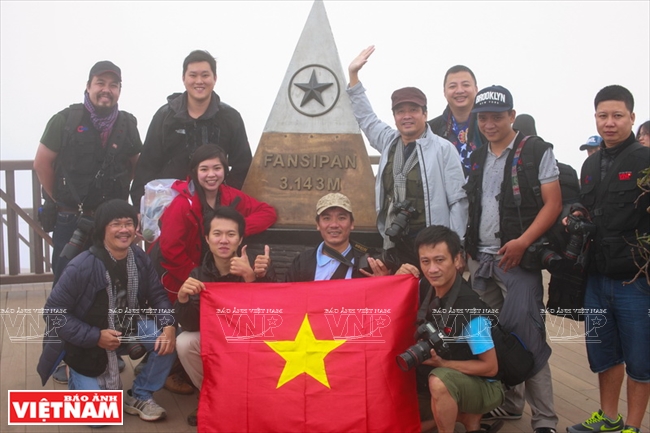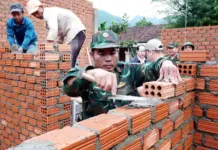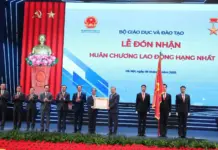In May 2012, we decided to make a trip to the top of Fansipan, nicknamed “the highest mountain in the Southern region”, or “the roof” of three countries in Indochina, with the help of Hoang Tung, a local photographer.
| The Guinness Book of World Records has granted two records to Sa Pa’s three-line cable car system, for its longest distance from departure to arrival (1,410m long), and its being the world’s longest three-line cable car system (6,292m). |
Our team had almost 30 members, starting from Ton Station 1,900m above sea level, and trekking through forests to 2,900m on the first day. From there, we could see the hamlets of the ethnic groups of the Mong, Dao, Giay and others who reside there on the mountain slopes.
At 2,800m, the wind blew strongly and the cold went deep into our body. However, we could see different kinds of trees growing and sticking firmly in the rock. In that moment of time, we understood more about the saying that often compared the characters of upright men with such strong, high trees.
In late afternoon, some local Mong ethnic tour guides prepared dinner and sleeping bags for us to rest overnight, which gave us energy for the following day to conquer the highest peak. A guide, named Sinh, told us that if we travelled in March, we would have a chance to enjoy the fantastic beauty of blooming water-rail flowers.
We woke up early the following day when clouds were still covering all the Northwest region. We brought along all necessities for our trip and continued to the mountain top. The road was a bit dangerous then, as the higher it was, the narrower it became. The abrupt mountain slopes, plus thick mists like rain, made the road so slippery, and we had to be very careful when climbing. Finally, someone shouted out with excitement, “We did it!” In front of us, there is a pyramid shaped metal block carved with the words “FANSIPAN 3,143m”. Although very tired, we were all very happy. The surrounding environment was a sea of thick mists which prevented us from seeing much. We took a national flag, holding it high and taking pictures with it to record such a significant moment in our lives.
|
The departure terminal is in Muong Hoa Valley. Photo: Tat Son/VNP |
| Sa Pa Fansipan cable car system has a transport capacity of up to 2,000 passengers per hour, with each cabin holding from 30-35 passengers. It helps reduce the time to reach Fansipan peak from two days on foot through forests down to 15 minutes by cable cars. |
Getting to the peak of Fansipan by cable cars
Sun Group, specialising in high-quality tourism, vacations, entertainment and real estate, built a three-line cable car system in Sa Pa, making it the most modern one of its kind in the world. The cars were put it into operation in February 2016, and since then, millions of domestic and foreign visitors have gone to Sa Pa to enjoy standing on “the roof of Indochina”.
We started our journey from the cable car station at Muong Hoa Valley. Designed in the Colonial architectural style from the 19th century, the station has sophisticated decorations, which makes it look like a palace. We were told that Sa Pa Fansipan cable car system can with stand strong winds and harsh weather that ensures safety for visitors.
In our cable car, there was a couple from Singapore who were on their honeymoon. They said they chose Fansipan as their first destination in Vietnam. To many Singapore people, they said, Fansipan peak is a mysterious site, among others in the country.
The couple shared with us their joy that made us feel stronger when we had to climb more than 600 stone steps from the last cable car stop to Fansipan peak. It was a big surprise when we met a group from the Vietnam Science and Technology Academy’s Geology Institute, who “conquered” the mountain top by trekking through forests, the same way we did four years earlier. We shared stories about how we got there, and about the pictures we took along the way. We all joyfully contemplated the magnificent view from Fansipan peak, the “roof” of Indochina.




